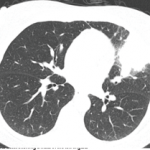The disease has been mapped to chromosome 4q33-q34 and mutations in 15-hydroxyprostaglandin dehydrogenase (HPGD), which is the main enzyme for prostaglandin degradation.9,10 There is also a link to a genetic mutation in the SLCO2A1 gene, which disturbs prostaglandin metabolism via a deficient transmembrane prostaglandin transporter.11
Genetic mutations in HPGD and SLCO2A1 lead to increased levels of prostaglandin E2 (PGE2), which appears to contribute to the pathogenesis of PDP.12,13 The severity of pachyderma and associated histological changes have been correlated with serum PGE2 levels and SLCO2A1 genotypes. PGE2 can mimic the activity of osteoblasts and osteoclasts, which may be responsible for the periosteal bone formation. Further, the prolonged local vasodilatory effects of PGE2 may explain digital clubbing.
PDP is self-limiting and usually stabilizes 5–20 years after onset.4 However, orthopedic disability can occur. The standard treatment includes non-steroidal anti-inflammatory drugs (NSAIDs) for pain relief. Bisphosphonates, such as pamidronate, have been used to treat PDP due to their antiresorptive and osteoclast inhibitory properties.
Reports exist of multiple medications used being simultaneously: celecoxib and colchicine for articular abnormalities, folliculitis and pachyderma; pamidronate for rheumatologic manifestations, such as bone lesions; vagotomy of vagal nerve branches to improve joint pain/swelling; and isotretinoin for skin symptoms.2
PDP and IBD have occurred simultaneously, specifically in Crohn’s disease. As of 2018, four such case reports had been found. In one case, a patient with a diagnosis of Crohn’s disease presented with cutis verticis gyrata, digital clubbing, arthralgias, periosteal new bone formation and hyperhidrosis. That patient received celecoxib and pamidronate plus prednisolone, which reportedly resulted in a good response.
Gastric hypertrophy, gastric ulcers and even endocrine abnormalities have been described with PDP.14 Interestingly, GI symptoms and pathology have been found in patients with SLCO2A1 mutations.15 An associated condition has been described as chronic enteropathy associated with SLCO2A1 gene mutation (CEAS).16
CEAS was initially proposed as a diagnosis based on multiple intestinal ulcers accompanied by an SLCO2A1 mutation, but has since evolved into its own entity. CEAS is an autosomal recessive hereditary disease caused by SLCO2A1 mutations.17 It mostly occurs in women.11 Patients generally have some form of anemia and hypoproteinemia from persistent gastrointestinal bleeding and intestinal protein loss.18 Inflammatory markers, such as CRP, are usually normal or slightly increased. Because CEAS mimics ileal Crohn’s disease with respect to ileal ulcers and stenosis, it is often difficult to distinguish the two by clinical features alone.11

